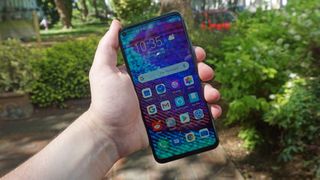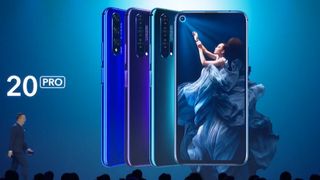Like the P30 Pro the Honor 20 Pro has no less than four rear cameras, as well as the latest Kirin 980 chipset – but it’s also shaking things up with new features like a ‘punch-hole’ front-facing camera rather than a notch, and side-mounted fingerprint sensor built into the power button.
In many ways, then, the Honor 20 Pro doesn’t feel like an affordable cousin to the Huawei P30 range, but rather a powerful and impressively specced smartphone beast in its own right – and with a price tag that sits below what you’d expect.
But Honor must have cut some corners to put out a phone with such cutting-edge features at a low price; the question is, which corners – and will you notice?
Honor 20 Pro price and release date

We don’t know the exact price for the Honor 20 Pro in the UK yet, but it starts at 8GB of RAM for €599 (about £525, $670, AU$970). We won't give our final verdict on the phone until we find out the official price from Honor.
Huawei smartphones (including Honor, a subsidiary of Huawei) are currently not available through US carriers or major retailers, though it's still possible to buy them. This usually means a higher cost or relying on an unverified online retailers, and software may not be optimized for US networks.
Huawei's other products, including laptops and tablets, are readily available in the US, and the firm is working to obtain clearance to market its phones, so we could see this handset officially launch in America in the future.
That price tag is comfortably below the Huawei P30’s £699 / AU$1,099 (roughly $910) launch price, so when the phone is made available after the Honor launch event on May 21, we’d expect it to retail for a reasonably low mid-range price.
We’ll update this article with the correct pricing when Honor announces it as well as a release date when we hear it.
Design

On the surface, the Honor 20 Pro doesn’t look particularly different from any standard Android phone – but looks can be deceiving, and there are some quirks to the Honor 20 Pro’s design.
The handset isn’t quite plus-sized, but it’s still large – with a body of roughly 154mm x 74mm x 9mm, some users may have trouble reaching the top of the screen, but it’s not exactly a burden to carry about.
The Honor 20 Pro display is something we’ll get into later, but while the phone has an impressive 91.6% screen-to-body ratio, there’s still just enough bezel to house a speaker and notification light right at the top.
On the right side of the handset you’ll find one of the Honor 20 Pro’s most useful features: the power button and fingerprint sensor are one and the same, so by the time you’ve picked up your phone and pressed the power button you’re in.
An indent makes this button easy to find without looking, and it’s a snappy system, so we found ourselves unlocking and able to use the phone much more quickly with this side-mounted sensor than with the now-common in-screen scanner. The button’s also at the perfect height to make it natural to use for most hands.

Image Credit: Honor
The volume rocker sits above the power button, and there’s a USB-C port on the bottom of the phone – sadly there’s no headphone jack, which was something the Honor View 20 did have, and it seems like a curious omission given that this is an affordable phone aimed at a younger audience.
On the back of the handset is its quad-camera setup – this makes for quite a prominent bulge, and the phone won’t sit flat on a surface because of it, but that’s arguably a small a price to pay for all the tech within.
The Honor 20 Pro is available in two colors – a purple shade and a green, both of which use, in the words of Honor, ‘Triple 3D Mesh’ and curved glass to create a bright, reflective pattern on the back. It’s certainly a more refined design than the Honor View 20, which was a little on the garish side, but the Honor 20 Pro is perhaps a little less eye-catching as a result.
Still, it’s a good-looking phone, with a nice balance between functionality and slick design.
Display
Advertisement
 One compromise you’re going to have to accept with this handset is the display, because the Honor 20 Pro screen is perhaps a little bit of a downgrade compared with competing devices.
One compromise you’re going to have to accept with this handset is the display, because the Honor 20 Pro screen is perhaps a little bit of a downgrade compared with competing devices.
The 6.26-inch screen uses LCD Full HD+ tech, which isn’t quite as good as the OLED of the Huawei P30 phones, so perhaps won’t display colors quite as well, although it has a great brightness range, and holds up well when viewed in direct sunlight.
Honor 20 Pro competitors like the Google Pixel 3a or OnePlus 6 do have better screens, with OLED and AMOLED displays respectively, so you’re not getting top-end specs here, and the screen quality is one of the main trade-offs for the low price.
Advertisement

There’s no notch intruding on the Honor 20 Pro’s screen; instead Honor has decided to go for a ‘punch-hole’ camera which means the lens is cut out of the display – the Honor View 20 and Samsung Galaxy S10 have similar arrangements.
Honor claims this is the smallest punch-hole camera on the market, at only 4.5mm, but between the hole in the screen and the edge of the display is a fair amount of real estate that isn’t used, so in effect the screen space lost is around the same amount as would be lost to a notch.
Comments
Post a Comment